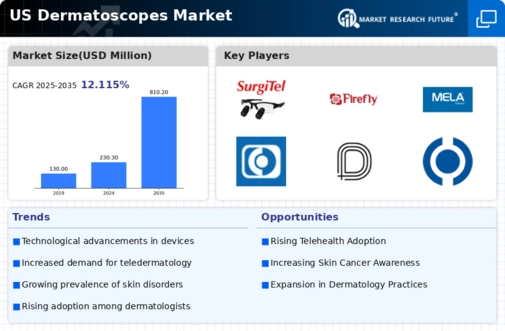The US Dermatoscopes Market is characterized by a diverse landscape of players competing to capture a share of the growing demand for advanced diagnostic tools in dermatology. This market is witnessing an upswing due to the rising prevalence of skin diseases, an increasing emphasis on early diagnosis, and technological advancements in dermatoscope design and functionality. The competitive dynamics are shaped by factors such as product innovation, strategic partnerships, marketing strategies, and the ability to address the unique needs of dermatologists and healthcare professionals.
Companies are continuously investing in research and development to improve the efficacy and user experience of their dermatoscopes, driving competition and pushing the boundaries of what's possible in dermatological diagnostics.
SurgiTel holds a prominent position within the US Dermatoscopes Market, leveraging its reputation for high-quality optical instruments tailored for healthcare professionals. The company is well-regarded for its commitment to clarity and precision, which resonates strongly with dermatologists seeking reliable tools for skin examinations. Its full range of products encompasses sophisticated magnification and illumination features, enhancing the user's ability to diagnose conditions accurately. SurgiTel's focus on ergonomics and user-friendly designs solidifies its appeal among clinicians and aids in reducing fatigue during procedures.
The company’s strong distribution channels across the US healthcare landscape ensure a wide market presence, allowing it to cater effectively to a variety of customers in the dermatology field.
Firefly Global has established itself as a competitive player in the US Dermatoscopes Market, known for its innovative approach to dermatoscope technology. The company’s product lineup includes a variety of high-performance dermatoscopes that emphasize portability, durability, and ease of use. Firefly Global’s commitment to addressing the needs of dermatology professionals is evident in their extensive research and development efforts, which aim to streamline diagnostics and improve patient outcomes. Furthermore, the company actively pursues strategic partnerships and collaborations to enhance its product offerings and expand its market reach within the US.
Firefly Global's strengths lie in its robust supply chain and responsive customer service, positioning it favorably against competitors while allowing for occasional mergers and acquisitions that further fortify its market standing.





















Leave a Comment